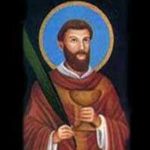
Pope St. Marcellinus was the 29th pope in history and led the Christian Church from 296 to 304 AD, a really tough time for Christians because of the Diocletianic Persecution.
This was when the Roman Empire was trying very hard to stop people from being Christians, making them choose between giving up their faith or facing severe punishment.
Not much is known about Marcellinus himself, and there are stories that he might have given up his faith under pressure, though later, people said this wasn’t true. This guide will take a closer look at his time as Pope, how he and the Church managed during these hard times, and what kind of mark he left on the Christian faith, especially when it was so hard to keep believing.
Early Life
Known as Marcellinus before becoming pope, he was born in an unnamed city in Rome sometime around 250. He likely worked for the Church in some type of capacity before taking on the position. On June 30, 296, the Church elected Marcellinus as the next pope.
Pagans and Persecution
Marcellinus inherited a papacy fraught with problems stemming from the pagans in Rome. Caesar Galerius was one of the main opponents of the Church. He often spoke against its teachings and rallied Roman citizens to follow him.
Roman Emperor Diocletian began listening to him and eventually implemented rules against Christianity. He first demanded that Christians leave the army and then asked soldiers to destroy any religious texts they found that related to the Church.
The emperor also confiscated homes and buildings owned by Christians. Not long before Marcellinus became pope, Diocletian began penalizing Christians, demanding that they renounce the Church or face execution.
Following Diocletian
In an attempt to help parishioners, Marcellinus first followed Diocletian. He handed over the Scriptures to the emperor and agreed to close some buildings. His attempts to side with the emperor were in vain though as Diocletian wanted to end the Church and stop the spread of Christianity.
Council of Bishops
There is some confusion regarding the last days of Marcellinus. This is due in part to the lack of official records from the time and the fact that historians added to his story in the 13th and later centuries. According to some reports, he grew despondent with the emperor and the actions he took. Marcellinus approached a large council of bishops and asked them to judge him based on those actions. In one version of this story, he stripped naked in front of them.
Re-election
Most reports indicate that Marcellinus removed himself from the papacy because he believed he did not deserve the position. After meeting with the bishops, they found that he had good intentions and asked him to reclaim the throne. When word reached the emperor, he was incensed that the man refused to stand by his side and turn his back on his beliefs. Diocletian orders soldiers to capture the pope and sentence him to death.
Death and Last Days
The persecution of Christians under Diocletian was so severe that historians believe up to 17,000 people died. When the pope refused to pay his respects to the false gods, the emperor sentenced him to beheading.
Legend claims that Marcellinus told the bishops to excommunicate him because he did not deserve a Christian burial or entry into heaven. Following his execution, he was likely buried in Rome with other former popes.
Though there is not any historical evidence to indicate that he died as a martyr or was beheaded, the Church canonized him as a martyr. He is now recognized as a saint by two different sects of the Christian faith.
Quick Facts About Pope Marcellinus
- Marcellinus was born somewhere in Rome, which was part of the Western Roman Empire.
- The Church does not list an official birth date for the pope but thinks he was born circa 250.
- He died in 304.
- No records list an official cause of death for Pope Marcellinus, but some historians believe he died as a martyr.
- His papacy began on June 30, 296.
- The papacy of Pope Marcellinus ended when he died in 304.
- Marcellus I became the next pope and ruled for less than one year.
Interesting Facts About Pope Marcellinus
- Christians celebrate the feast day of Pope Saint Marcellinus on April 26. In the Serbian Orthodox Church, they celebrate his feast day on June 7.
- According to the official Church records, Marcellinus was pope for seven years and 301 days or 2,856 days.
- The General Roman Calendar set his feast day on April 26 sometime during the 13th century. This calendar also shows that he shares his feast day with Saint Cletus. The Church recognizes him as a saint because of his alleged martyrdom.
- During his tenure as pope, Marcellinus established a Christian state called Armenia. This state would fall under the control of Tridates III in 301.
- Due to the similar name of his successor, Marcellus I, some records confuse the two men. Marcellinus ruled for much longer than Marcellus did.